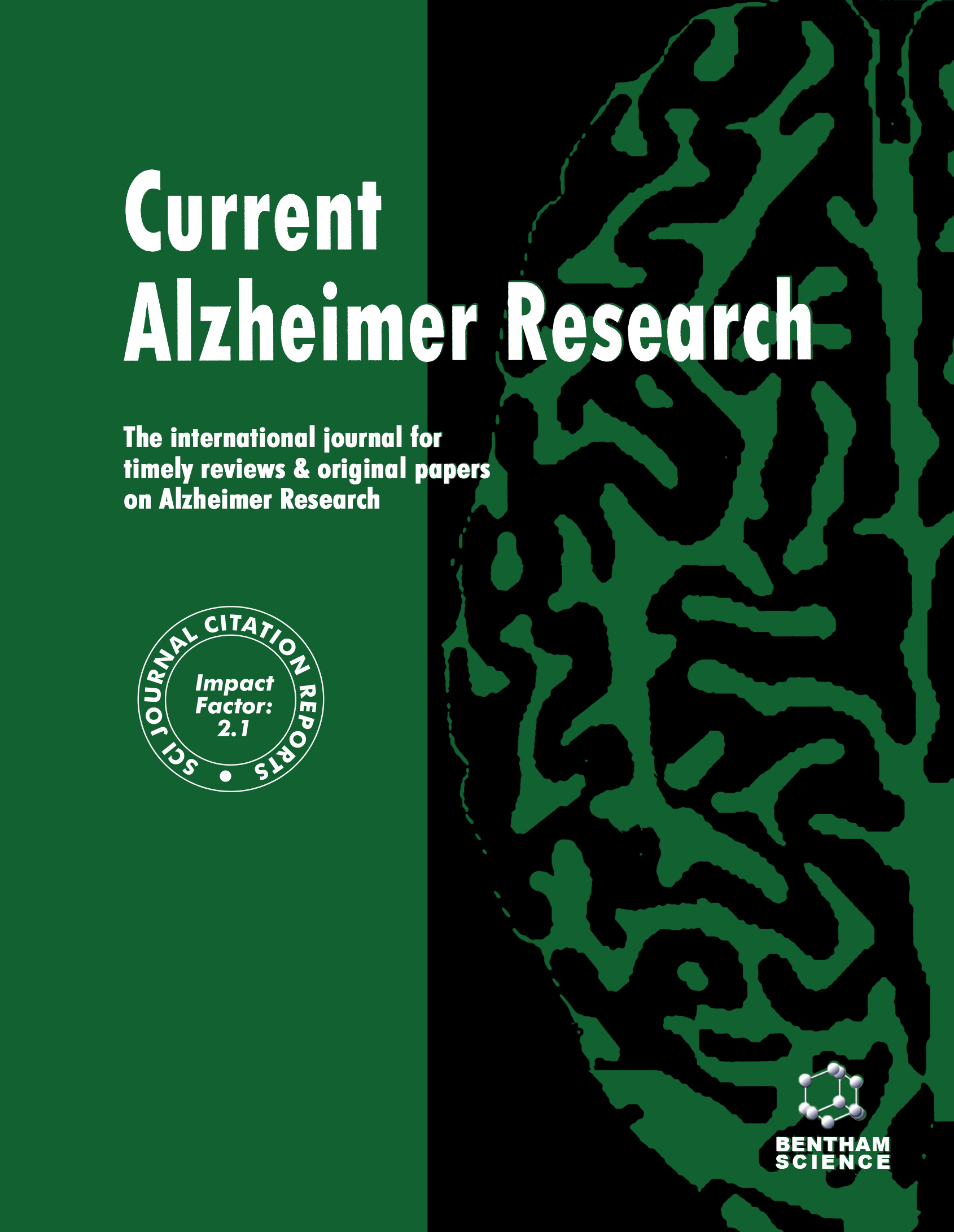- Home
- A-Z Publications
- Current Alzheimer Research
- Previous Issues
- Volume 17, Issue 12, 2020
Current Alzheimer Research - Volume 17, Issue 12, 2020
Volume 17, Issue 12, 2020
-
-
Microglial Store-operated Calcium Signaling in Health and in Alzheimer’s Disease
More LessThe dysregulation of calcium signaling mechanisms in neurons has been considered a contributing factor to the pathogenesis evident in early-onset Alzheimer’s Disease (AD). However, considerably less is known concerning the possible impairment of Ca2+ mobilization in resident immune cell microglia. This review considers findings which suggest that a prominent pathway for non-excitable microglial cells, store-operated calci Read More
-
-
-
Fine Tuning of Intracellular Ca2+ Content by Pharmacological Agents – A Strategy to Prevent Synapse Loss in Alzheimer Disease Hippocampal Neurons
More LessAlzheimer disease is the dominant form of elderly dementia. Today all clinical trials that target β-amyloid have failed to indicate that β-amyloid may not be a causative agent in AD pathogenesis. Thus there is a need to search for alternative ways to treat AD patients. Neuronal store-operated calcium entry is a fine-tuning mechanism that regulates intracellular Ca2+ content. Recent evidence suggests that store-operated calciu Read More
-
-
-
Rectifying Attenuated Store-Operated Calcium Entry as a Therapeutic Approach for Alzheimer’s Disease
More LessAlzheimer’s disease (AD) is the most common neurodegenerative disorder. Although the pathological hallmarks of AD have been identified, the derived therapies cannot effectively slow down or stop disease progression; hence, it is likely that other pathogenic mechanisms are involved in AD pathogenesis. Intracellular calcium (Ca2+) dyshomeostasis has been consistently observed in AD patients and numerous AD models and Read More
-
-
-
Impairment of Store-operated Calcium Entry: Implications in Alzheimer’s Neurodegeneration
More LessAuthors: Jing Zhou and Shengzhou WuAlzheimer's disease (AD) is an insidious and progressive neurodegenerative disorder. Dysfunction of central cholinergic neurons, amyloid aggregation and deposition,oxidative stress,and biometal dyshomeostasis has been regarded as the major pathogenic mediators in this devastating disease. However, strategies derived from these hypotheses fail to slow down or stop the progression of AD, warranting a combination o Read More
-
-
-
Association Serum S100B Protein in Alzheimer’s Disease: A Case Control Study from South India
More LessBackground: Recent evidence points to a possible link between the inflammatory modulatory protein S100B protein and the pathogenesis of Alzheimer’s disease (AD). Objective: To investigate the elevated levels of serum S100B protein among AD in a South Indian cohort and its correlation with severity of cognitive impairment. Methods: A cross-sectional study was conducted with 100 AD patients and 100 age an Read More
-
-
-
A Comparison of Neurocognitive Decline in Older Adults in Same-Sex and Opposite-Sex Relationships
More LessAuthors: Riccardo Manca and Annalena VenneriBackground: Individuals from sexual minorities experience health inequalities that have detrimental impacts on their health, especially in the elderly, by exacerbating care needs and symptoms of chronic conditions such as Alzheimer’s disease (AD). Neurocognitive decline due to AD in the sexual minority population remains under-investigated. However, being in a relationship may mitigate the risk of experiencing cognitive i Read More
-
-
-
Carotid Arterial Stiffness and Cerebral Blood Flow in Amnestic Mild Cognitive Impairment
More LessAuthors: Tsubasa Tomoto, Jun Sugawara, Takashi Tarumi, Collin Chiles, Bryon Curtis, Evan P. Pasha, C. M. Cullum and Rong ZhangBackground: Central arterial stiffness is an emerging risk factor of age-related cognitive impairment and Alzheimer’s disease (AD). However, the underlying pathophysiological mechanisms remain unclear. Objective: We tested the hypothesis that carotid arterial stiffness is associated with reduced cerebral blood flow (CBF) and increased cerebrovascular resistance (CVR) in patients with amnestic mild cognitive impairment ( Read More
-
-
-
Association of Cerebrospinal Fluid Adiponectin Levels With Cerebral Glucose Metabolism In Mild Cognitive Impairment: A Pilot Study
More LessAuthors: Takuya Ataka, Noriyuki Kimura, Takeshi Mizukami, Hirotatsu Uchida and Etsuro MatsubaraBackground: Adiponectin has been implicated in the pathophysiology of dementia, especially Alzheimer’s disease. However, the association between cerebrospinal fluid (CSF) adiponectin levels and positron emission tomography (PET) imaging remains unclear. Objective: To explore whether CSF adiponectin levels are associated with 11C-Pittsburgh compound B (PiB) or 18F-fluorodeoxyglucose (FDG) uptake in amnest Read More
-
-
-
Salivary Aβ Secretion and Altered Oral Microbiome in Mouse Models of AD
More LessAuthors: Angela M. Floden, Mona Sohrabi, Suba Nookala, Jay J. Cao and Colin K. CombsBackground: Beta amyloid (Aβ) peptide containing plaque aggregations in the brain are a hallmark of Alzheimer’s Disease (AD). However, Aβ is produced by cell types outside of the brain suggesting that the peptide may serve a broad physiologic purpose. Objective: Based upon our prior work documenting expression of amyloid β precursor protein (APP) in intestinal epithelium we hypothesized that salivary epithelium mig Read More
-
Volumes & issues
-
Volume 21 (2024)
-
Volume 20 (2023)
-
Volume 19 (2022)
-
Volume 18 (2021)
-
Volume 17 (2020)
-
Volume 16 (2019)
-
Volume 15 (2018)
-
Volume 14 (2017)
-
Volume 13 (2016)
-
Volume 12 (2015)
-
Volume 11 (2014)
-
Volume 10 (2013)
-
Volume 9 (2012)
-
Volume 8 (2011)
-
Volume 7 (2010)
-
Volume 6 (2009)
-
Volume 5 (2008)
-
Volume 4 (2007)
-
Volume 3 (2006)
-
Volume 2 (2005)
-
Volume 1 (2004)
Most Read This Month
Article
content/journals/car
Journal
10
5
false
en

Most Cited Most Cited RSS feed
-
-
Cognitive Reserve in Aging
Authors: A. M. Tucker and Y. Stern
-
- More Less

